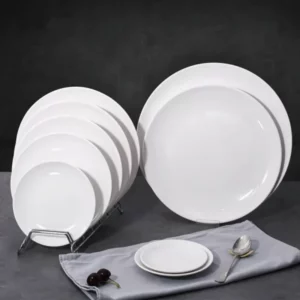In fast-paced foodservice operations, wholesale melamine plates have emerged as a dependable option due to their strength, cost-efficiency, and long-term usability. From cafeterias to healthcare facilities and outdoor catering setups, these plates offer a reliable alternative to fragile ceramic or single-use tableware. This article outlines the primary benefits, usage tips, and critical considerations when integrating wholesale melamine plates into institutional or commercial environments.
Durability Advantages of Wholesale Melamine Plates
A key advantage that sets wholesale melamine plates apart is their long-lasting structural strength under frequent use.Constructed from thermoset plastic, these plates are highly resistant to chipping, breaking, and cracking—ideal for environments where equipment faces frequent use and handling.
- Impact resistance: Unlike porcelain, melamine won’t shatter when dropped, making it safer in settings such as schools or hospitals.
- Lightweight properties: Staff can carry and transport stacks of plates easily, reducing fatigue and improving service speed.
- Temperature tolerance: Suitable for serving hot foods, melamine plates maintain their shape and color without warping under typical food temperatures (up to ~120°C).
This durability translates to fewer replacements and lower long-term costs for large-scale users.
Functional Design Variety of Wholesale Melamine Plates
Today’s wholesale melamine plates are engineered in a range of shapes, depths, and layout options to meet specific foodservice needs. Instead of traditional round forms alone, manufacturers produce plates with structural and visual diversity to align with various menu formats and presentation standards.
Examples include:
- Segmented trays for keeping components separate—ideal in institutional meals.
- Shallow wide rims for easy stacking and efficient plating during service.
- Color-based differentiation to signal dietary categories like vegetarian or allergen-free meals.
- Matte or textured finishes to enhance grip and reduce sliding on serving trays.
This variety allows kitchen teams to match tableware style to functionality without sacrificing durability.
Safety Considerations When Using Wholesale Melamine Plates
While wholesale melamine plates are food-safe under standard conditions, there are best practices and limits that operators should understand:
- Do not use in microwaves: Exposure to direct, high heat can damage melamine and compromise its safety.
- Monitor surface condition: Deep scratches or cracks may harbor bacteria and should prompt immediate replacement.
- Compliance with food-contact standards: Ensure that melamine tableware meets local safety certifications (e.g., FDA, EU 10/2011) for food contact materials.
Adhering to usage guidelines extends product life and ensures a hygienic dining experience.
Cleaning and Care Tips for Wholesale Melamine Plates
Maintaining wholesale melamine plates requires minimal effort but benefits from consistent routines to preserve appearance and function.
Recommended care practices:
- Use soft cleaning tools: Avoid steel wool or harsh scrubbers that can scratch surfaces.
- Opt for moderate dishwashing cycles: High-temperature sanitization is fine, but excessive heat should be avoided.
- Allow full drying before stacking: Reduces mold and odor risks in humid environments.
- Conduct periodic inspections: Remove plates with visible damage from circulation to maintain hygiene standards.
Proper cleaning contributes to plate longevity and keeps serviceware presentation-ready.
Storage and Supply Logistics of Wholesale Melamine Plates
Efficient storage and movement of wholesale melamine plates are critical in large kitchens, commissaries, and institutional pantries.
- Standardized shapes allow dense stacking without damage or instability.
- Protective packaging during bulk delivery reduces breakage and eases unloading.
- Low-temperature storage compatibility means no refrigeration is required, saving space and energy.
- Clear labeling and sorting systems help staff locate specific plate types for different meal types or diets.
By minimizing space requirements and simplifying handling, storage logistics improve overall kitchen efficiency.
Environmental and Operational Benefits of Wholesale Melamine Plates
Although melamine is not biodegradable, wholesale melamine plates offer sustainability gains through long-term reusability. Over time, the environmental footprint per use is significantly lower compared to single-use plastic or disposable alternatives.
Key advantages include:
- Waste reduction: Replacing disposables with melamine minimizes landfill contributions.
- Reduced need for replacements: Melamine resists everyday impact better than ceramic, allowing for extended use.
- Water and energy savings: Lightweight plates require less water and energy in dishwashers.
When properly maintained, these plates can serve thousands of meals, offering both environmental and operational value.
Conclusion
Wholesale melamine plates are a smart investment for foodservice providers aiming to balance efficiency, safety, and sustainability. Their durability, practical design options, and ease of maintenance make them ideal for high-volume dining operations. By understanding material limitations and applying consistent care, institutions can maximize their return while delivering reliable, hygienic service to every diner.
